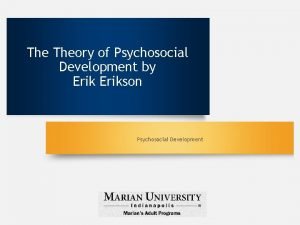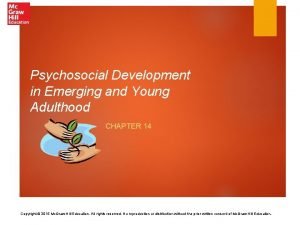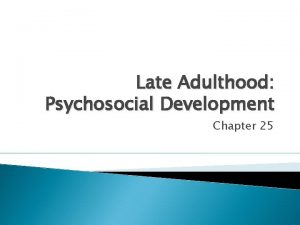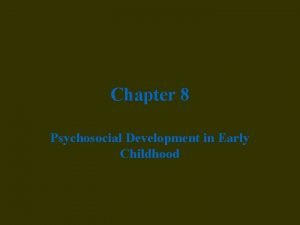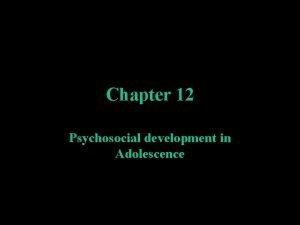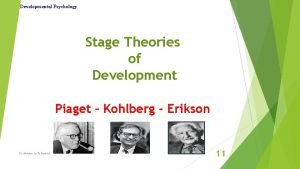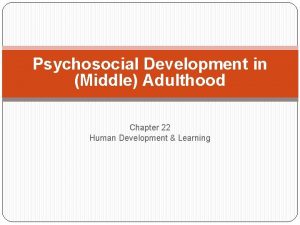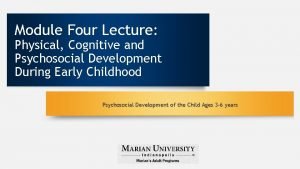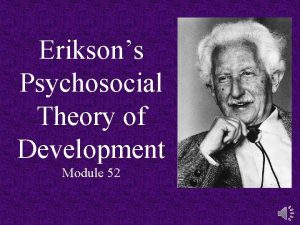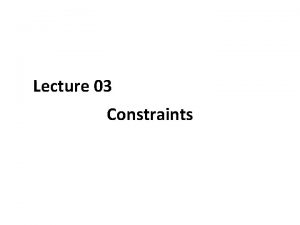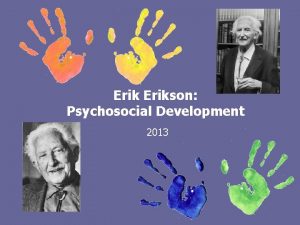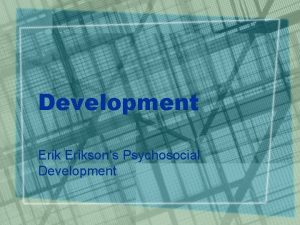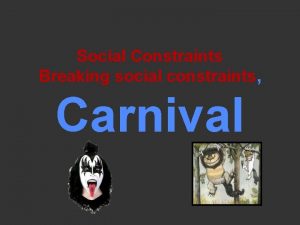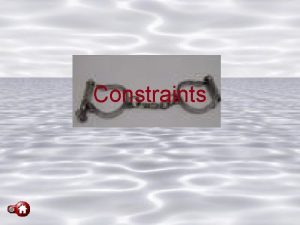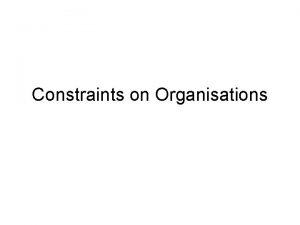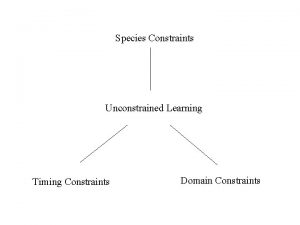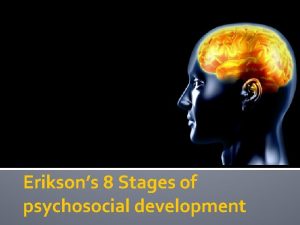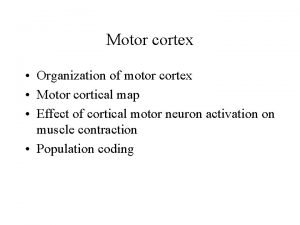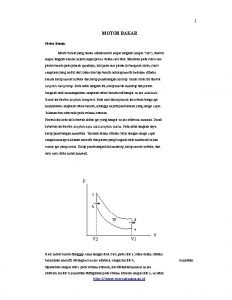chapter 13 Psychosocial Constraints in Motor Development Psychosocial


















- Slides: 18

chapter 13 Psychosocial Constraints in Motor Development

Psychosocial Influences • Interaction of individual (functional) constraints with environmental (sociocultural) constraints • Emotions, perceived ability, and other personal attributes

Self-Esteem • Self-evaluation of individual capability – General – Specific (physical ability, appearance, social skills) • Individual’s belief in correctness of selfevaluation more important than accuracy of self-evaluation (Weiss, 1993) • Specific domains (social, academic, physical)

Development of Self-Esteem • Children under 10 depend on appraisals of and comparisons with peers to determine physical competence (Horn & Hasbrook, 1986; Horn & Weiss, 1991). • Children of all ages develop self-esteem from feedback and appraisals from teachers and coaches (Smoll & Smith, 1989).

Question: Describe how self-esteem can act as a constraint in the following: • A young child • A professional athlete

Emotions • Emotions associated with participation in sport and physical activity affect selfesteem development. • Enjoyment in pre- and young adolescents is furthered by perceptions of high ability, mastery, low parental pressure, and greater parent and coach satisfaction (Brustad, 1988; Scanlan & Lewthwaite, 1986; Scanlan, Stein, & Ravizza, 1988).

Causal Attributions • Causal attributions are the reasons people give for their successes and failures. • Individuals tend to act in ways that confirm their beliefs. (continued)

Causal Attributions (continued) • An individual with high self-esteem makes the following causal attributions: – Internal—individual responsible for own success or failure – Stable—outcome-influencing factors consistent from one situation to next – Controllable—individual in control of outcomeinfluencing factors (continued)

Causal Attributions (continued) • An individual with low self-esteem makes the following causal attributions: – External—success and failure due to influences outside the individual – Unstable—outcome based on fluctuating influences (e. g. , luck) – Uncontrollable—individual unable to control or influence outcome

Children’s Attributions • Children with high self-esteem give internal, stable, controllable reasons for outcomes. • Children with low self-esteem tend to make inaccurate attributions about outcomes and exhibit the following behaviors: – Unwillingness to try challenging tasks – Lack of effort to do well – Avoidance of participation

Adults’ Attributions Adults evaluate themselves in these ways: • Observing past and present accomplishments and failures • Comparing themselves with others • Receiving verbal persuasion from others • Observing their physiological state or fitness level

Question: How can causal attributions act as a constraint on motor development in the following persons? • High school female learning basketball • All-Star Little League pitcher

Motivation to Participate • Self-esteem and motivation to participate are related in both children and adults. • High motivation level is essential for beginning or maintaining participation in sports and physical activities.

Children’s Reasons for Persistence Desire to • be competent by improving skills or attaining goals, • affiliate with or make new friends, • be part of a team, • undertake competition and be successful, • have fun, and • improve fitness (Weiss, 1993).

Children’s Reasons for Dropping Out • • Dislike of coach Lack of playing time Too much pressure Too much time required Overemphasis on winning Lack of fun Lack of progress Lack of success

Question: Given children’s reasons for participating or dropping out, how can a coach or instructor change task or environment to increase the chance that a child will stay in sports?

Adult Participation Adult participation levels may be limited by these factors (Mc. Pherson, 1986): • • Stereotypes of appropriate activity levels Limited access to facilities and programs Childhood experiences Concerns over personal limitations on exercise Belief that exercise is harmful to health Lack of role models Lack of knowledge about appropriate exercise programs

Psychosocial Influences Across the Life Span • Physical activity has been proven beneficial at all ages. • Participation in physical activity reflects motivation to participate. • Motivated individuals at all ages tend to have higher levels of self-esteem. • Self-esteem can be improved through efforts of peers, teachers, coaches, and significant others.
 Psychosocial stages
Psychosocial stages Chapter 7 human growth and development
Chapter 7 human growth and development Psychosocial development in young adulthood
Psychosocial development in young adulthood Psychosocial development in late adulthood
Psychosocial development in late adulthood Initiative vs guilt stage
Initiative vs guilt stage Developmental crisis
Developmental crisis Psychosocial development in early childhood
Psychosocial development in early childhood Psychosocial development in adolescence
Psychosocial development in adolescence Erickson's psychosocial theory of development
Erickson's psychosocial theory of development Early adulthood 19-45
Early adulthood 19-45 Psychology stages of development
Psychology stages of development Middle adulthood psychosocial development
Middle adulthood psychosocial development Define physical cognitive and psychosocial development
Define physical cognitive and psychosocial development Erik erikson theory
Erik erikson theory Chapter 10:2 physical changes of aging
Chapter 10:2 physical changes of aging Pony motor starting method diagram
Pony motor starting method diagram A motor unit is
A motor unit is What is hunting in synchronous motor
What is hunting in synchronous motor Motor parts name
Motor parts name
